Introducing Manado and the Minahasa Region
An exotic culture in a remote corner of Indonesia
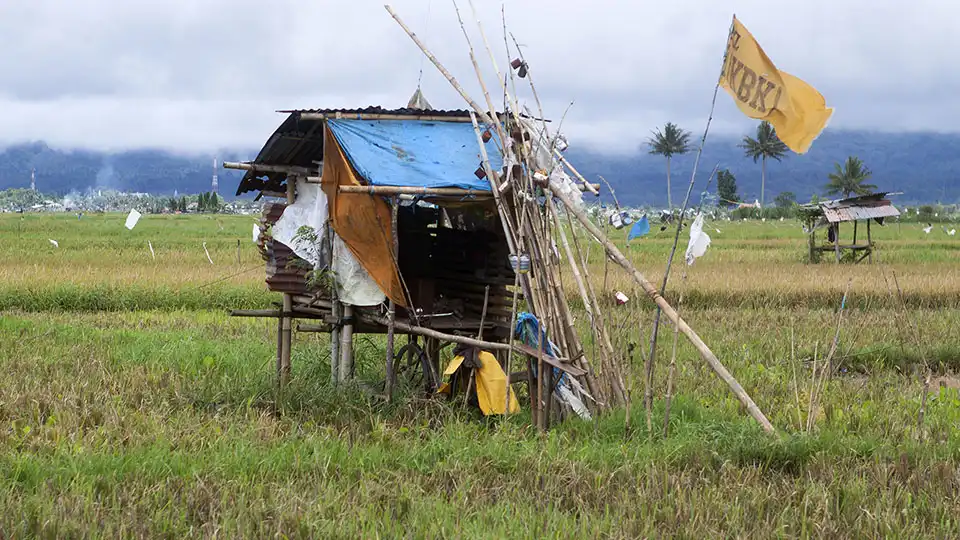
Rice Paddy near Tomonhon, Minahasa, Indonesia
Discover Manado and the captivating beauty and rich cultural heritage of the Minahasa region in North Sulawesi, Indonesia. Manado is an exotic location redolent with spices and jungle produce and very different culturally from much of the rest of the archipeligo. When we were there, we tasted fresh cinnamon growing by the roadside and had the smell of cloves everywhere. Around every corner is a new exotic experience.
Nestled between lush mountains and crystal-clear seas, this enchanting destination offers a blend of natural wonders and vibrant traditions. Be careful though, of what you eat! There are some unusual proteins
Immerse yourself in the stunning landscapes of the Minahasa highlands, where majestic volcanoes, terraced rice fields, and picturesque lakes await. Dive into the pristine waters of Bunaken National Marine Park, a paradise for snorkeling and diving enthusiasts. Explore charming traditional villages, witness intricate traditional ceremonies, and savor the unique flavors of Minahasan cuisine. This region, unlike many other parts of Indonesia, is predominantly Christian, and the food and customs reflect the different religion.
Get ready for an unforgettable journey as you experience the warmth and hospitality of the Minahasa people in this culturally rich and naturally diverse region.
But again, be careful with the cuisine. Always ask what your protein is. The local cuisine includes options such as snake meat, fruit bat and dog meat. Recent reports have stated that the dog meat market in Tomohon has been closed down. We visited that market a few years ago, and it was heartbreaking. The dogs understood their fate.
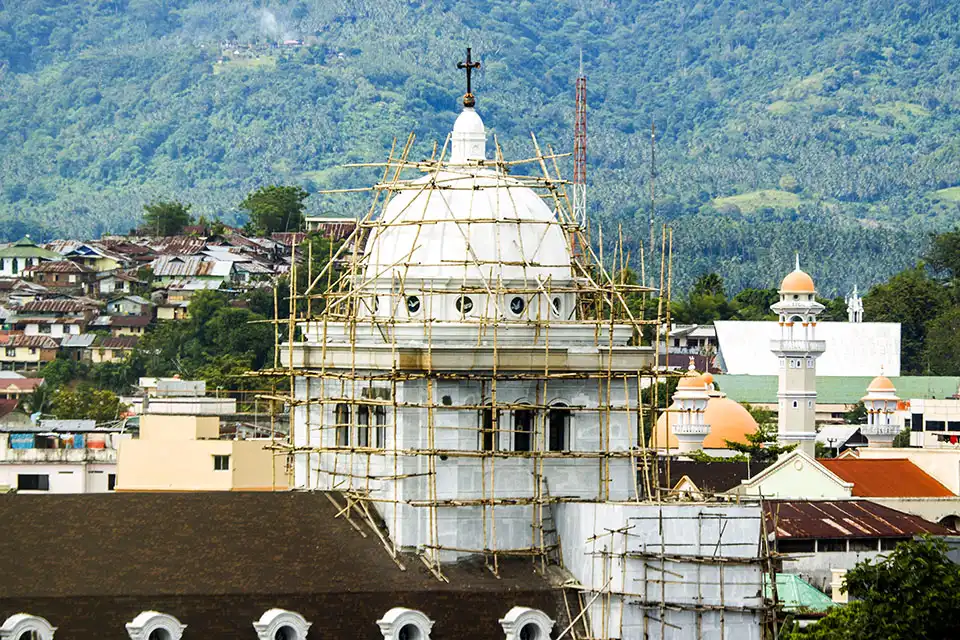
A Church and a Mosque side by side in Manado
Some History of the Minahasa Region
The history of Manado and the Minahasa region spans centuries and is marked by various influences and events that have shaped its cultural and historical landscape.
Ancient Times
In ancient times, the Minahasa region was inhabited by indigenous tribes known as the Minahasan people. The Minahasan culture flourished, characterized by their unique customs, languages, and cultural practices. The Minahasan people were known for their agricultural expertise, particularly in cultivating cloves, nutmeg, and other valuable spices that attracted traders from other regions.
It is thought that the Minahasa people originally came from the north, from the present–day Phillipines, as thereare many ethnographic and linguistic similarities. There are also strong pre–colonial links with the Sultanate of Ternate
Colonial Era
Initially Manado was settled by the Spanish in the mid 16th century. The name Manado comes from the Spanish word Manados, although it is not known in what context this was used.
In the 17th century, the Minahasa region came under the control of the Dutch East Indies Company (VOC) during the colonial period. The Dutch established a trading post in Manado, which played a significant role in the spice trade. The Dutch influence brought about changes in governance, administration, and religion. Christianity was introduced, and the majority of the Minahasan people embraced the faith, shaping the region's religious landscape to this day.
World War II
During World War II, Manado and the Minahasa region experienced significant turmoil. The area was occupied by Japanese forces from 1942 to 1945. The local population endured hardship, including forced labor and harsh living conditions. The region also witnessed various military engagements between Japanese and Allied forces, resulting in destruction and loss of life.
Independence and Modern Era
After Indonesia declared independence from Dutch colonial rule in 1945, Manado became part of the newly formed Republic of Indonesia. The region played an active role in the struggle for independence and saw the rise of local leaders advocating for self-determination. Since then, Manado and the Minahasa region have undergone significant development and have become important economic and cultural centers in North Sulawesi. Infrastructure projects, including roads, airports, and educational institutions, have contributed to the region's growth.
Cultural Resilience
Throughout its history, the Minahasan people have demonstrated resilience in preserving their cultural identity. Despite colonial influences and external changes, the Minahasan traditions, language, and cuisine have remained strong and are celebrated by the local community. Traditional ceremonies, such as the Minahasa wedding ceremony and war dances, continue to be performed, showcasing the rich cultural heritage of the region.
Today, Manado and the Minahasa region stand as a testament to the rich historical and cultural heritage of the area, attracting visitors from around the world who are eager to explore its vibrant past, experience its unique traditions, and appreciate its natural beauty.
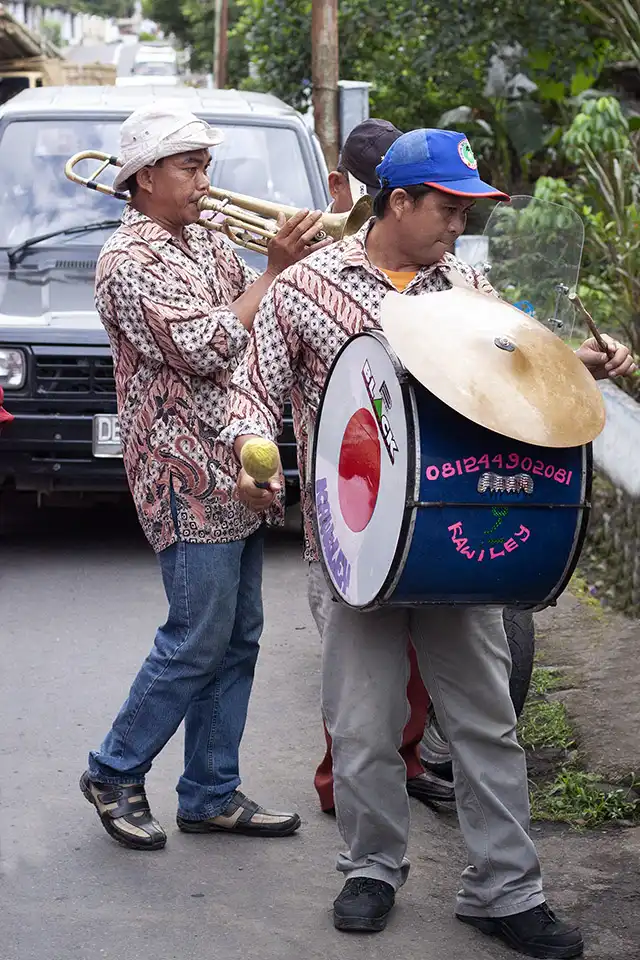
A Minahasan band plays music during a wedding ceremony
About the Area
Location of Manado in Sulawesi
Manado is situated on the northeastern coast of the island of Sulawesi in Indonesia. It is the capital city of the North Sulawesi province and serves as a prominent gateway to the region.
Geographic Coordinates
The geographic coordinates of Manado are approximately 1.50° N latitude and 124.85° E longitude.
Position on Sulawesi Island
Sulawesi, formerly known as Celebes, is one of the largest islands in Indonesia. It is located in the central part of the Indonesian archipelago, between Borneo (Kalimantan) to the west and Papua (New Guinea) to the east. Manado is positioned on the northeastern tip of Sulawesi, along the Celebes Sea.
Proximity to Other Major Cities
Manado is located approximately 2,160 kilometers northeast of the Indonesian capital, Jakarta. It is relatively close to other major cities on Sulawesi, such as Makassar (also known as Ujung Pandang), the capital of South Sulawesi, which is situated about 400 kilometers southwest of Manado.
Access and Transportation
Manado is well-connected by air, sea, and land transportation. The city is served by the Sam Ratulangi International Airport, which provides domestic and international flights. Additionally, Manado has a seaport, the Port of Manado, facilitating maritime transportation and connecting the city to other parts of Indonesia.
Transportation within Manado includes buses, taxis, and ojeks (motorcycle taxis), providing convenient options for getting around the city and exploring the surrounding areas.
The location of Manado on the northeastern coast of Sulawesi offers strategic access to the beautiful marine parks, stunning landscapes, and rich cultural heritage of the region, making it a captivating destination for visitors from around the world.
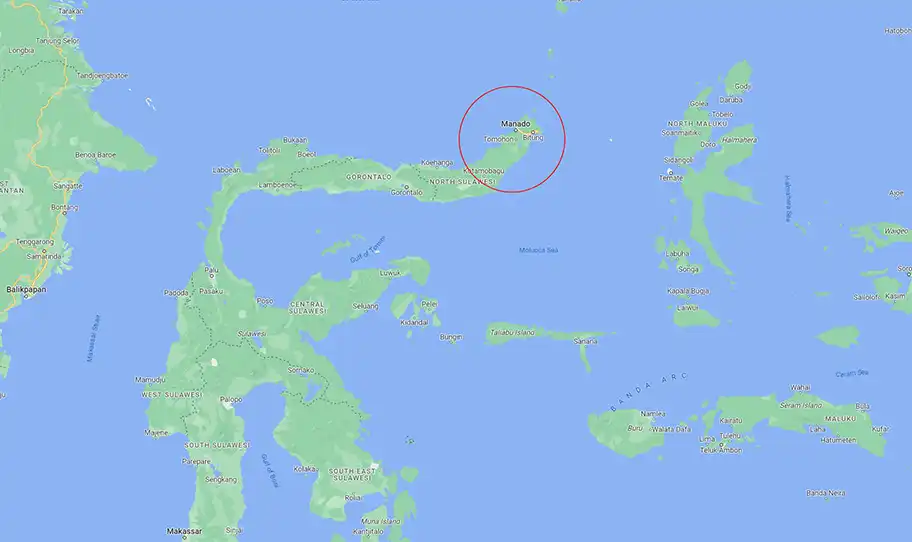
Manado in the Sulawesi Utara (North Sulawesi) Region
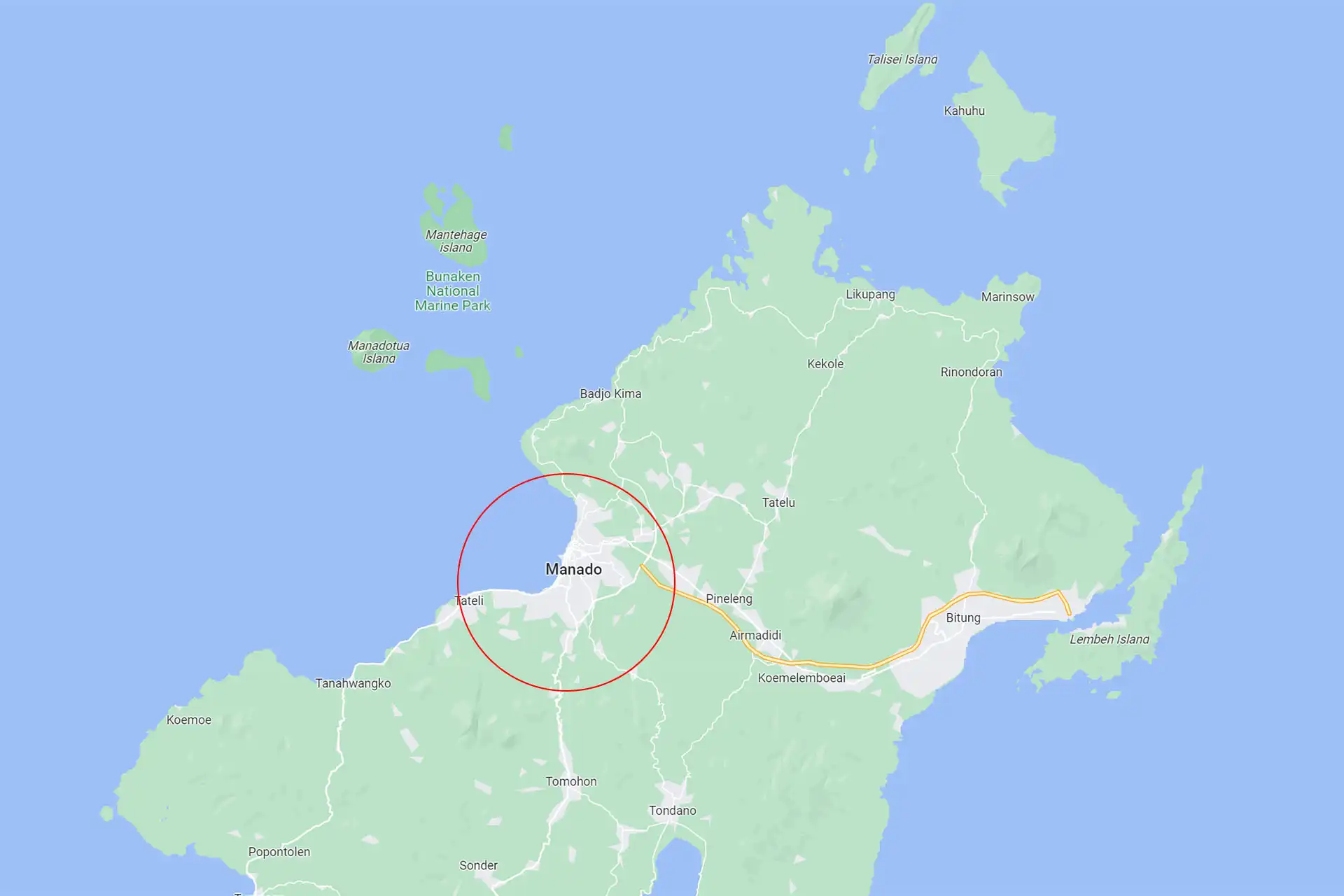
Manado and the Minahasa Area
The People
Indonesia is an incredibly rich and diverse country. Although often described as the world's most populous Muslim country, that statement hides the incredible cultural diversity that exists. The Minahasa people are an indigenous ethnic group that inhabits the Minahasa region in North Sulawesi, Indonesia. They have a rich history that spans centuries, characterized by their resilience, cultural distinctiveness, and interactions with various external influences. The area is predominantly Christian.
When To Go
The best time to visit Manado is typically during the dry season, which occurs from April to October. This period offers pleasant weather with lower humidity and minimal rainfall, making it ideal for outdoor activities and exploring the region's natural attractions.
The months of July and August are particularly popular among tourists, as the weather is generally sunny and suitable for activities such as diving and snorkeling in the pristine waters of the Bunaken National Marine Park.
It's important to note that Manado experiences a tropical climate, and even during the dry season, there may be occasional showers. However, they are usually short-lived and do not significantly affect travel plans.
It's also worth considering that Manado can be visited year-round, as even during the wet season (November to March), the rain showers are usually intense but brief, and the region's lush landscapes become even more vibrant. However, water visibility for diving and snorkeling might be slightly reduced during this period.
Ultimately, the best time to visit Manado depends on your preferences and the activities you plan to engage in. Consider your interests, weather conditions, and the specific experiences you want to enjoy to determine the most suitable time for your visit.
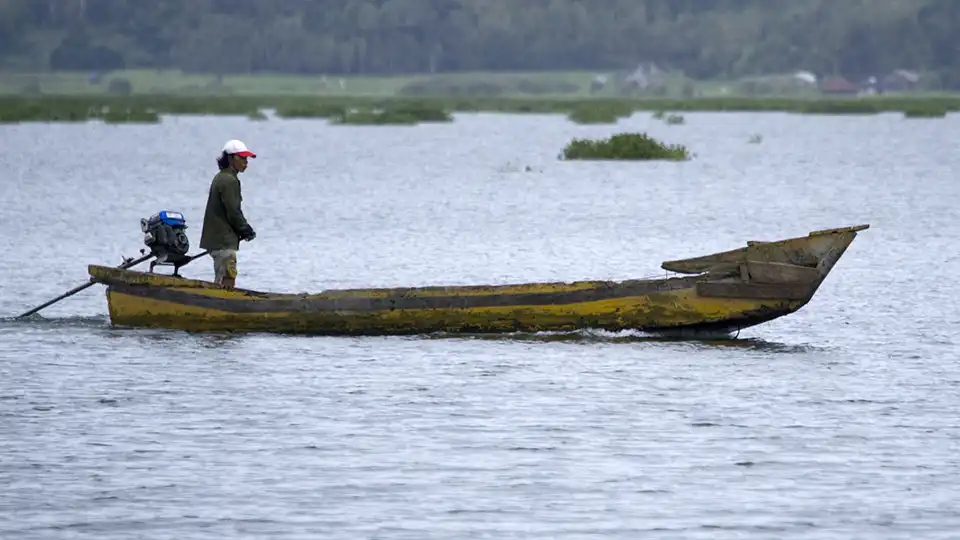
Fisherman and Canoe on Lake Tondano
Things to Do in Manado
- Explore Bunaken National Marine Park, known for its pristine coral reefs, diverse marine life, and excellent diving and snorkeling opportunities
- Go snorkeling or diving to discover the underwater paradise with colorful coral gardens, tropical fish, and even the chance to spot sea turtles and dolphins
- Visit Tondano Lake, a picturesque volcanic lake surrounded by lush greenery and hills, where you can take a boat ride, enjoy the scenic beauty, and visit traditional villages nearby
- Take a boat tour to the nearby islands, such as Siladen and Lembeh, and enjoy their pristine beaches, crystal-clear waters, and abundant marine biodiversity
- Explore the Minahasa Highland, a mountainous region with breathtaking landscapes, terraced rice fields, traditional villages, and opportunities for trekking, hiking, and wildlife spotting
- Discover the cultural heritage at the Waruga ancient burial sites, where unique stone sarcophagi of the Minahasa ancestors are preserved, offering insights into the region's history and traditions
- Explore the bustling traditional market of Manado, Pasar Bersehati, to experience the vibrant local atmosphere, browse through local products, and taste delicious street food
- Taste the local culinary delights, such as spicy Minahasan dishes including Manado-style grilled fish, tinutuan (a traditional porridge), and spicy dabu-dabu condiment
- Visit the Ban Hin Kiong Temple, a Chinese temple in Manado, known for its intricate architecture, colorful decorations, and cultural significance
- Experience the warm hospitality of the Minahasa people, interact with the locals, and learn about their customs, traditions, and way of life
- Enjoy the vibrant city atmosphere of Manado, explore its modern shopping centers, dine at waterfront restaurants, and experience the bustling nightlife
- Take part in traditional cultural festivals and events, such as the Manado City Festival or the Minahasa Ethnic Festival, to witness traditional dances, music performances, and cultural showcases
Waruga Burials
Worth a special mention for their cultural significance, the Waruga are ancient burial sites found in the Minahasa region. They are unique stone sarcophagi that were used by the Minahasa people for burial purposes in the past.
The Waruga are characterized by their rectangular shape and coverings made of carved stone. They were traditionally placed above the ground and arranged in rows, forming a collective burial site for multiple individuals. Each sarcophagus is intricately decorated with carvings and engravings, often depicting various symbols, motifs, or representations of the deceased's social status and achievements.
The Waruga burial sites are significant cultural and historical landmarks in the Minahasa region. They provide insights into the burial customs and traditions of the Minahasa people, reflecting their beliefs and practices related to death and the afterlife.
Today, many Waruga sites can be visited as part of cultural and historical tours in the Minahasa region. They serve as a reminder of the rich heritage and traditions of the Minahasa people and are valued as important cultural artifacts.
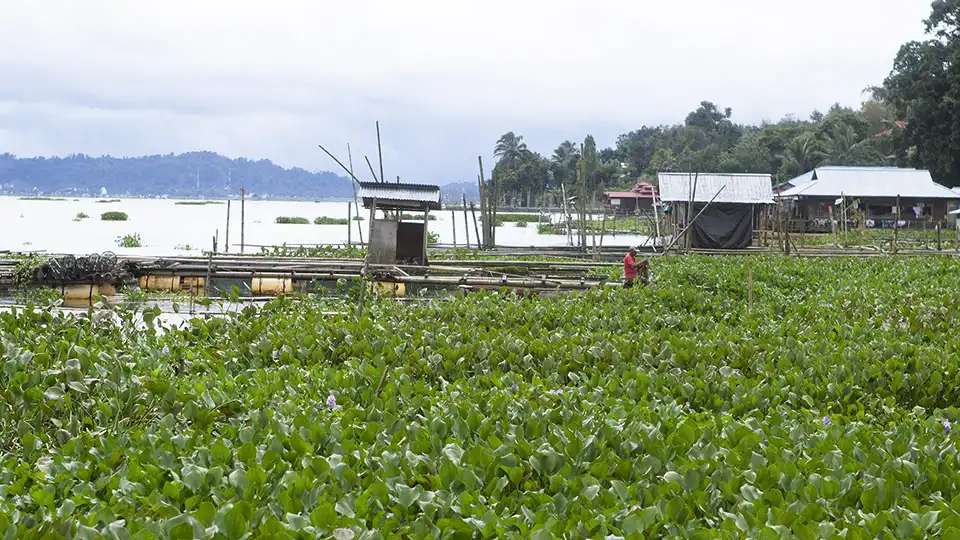
Lake Tondano
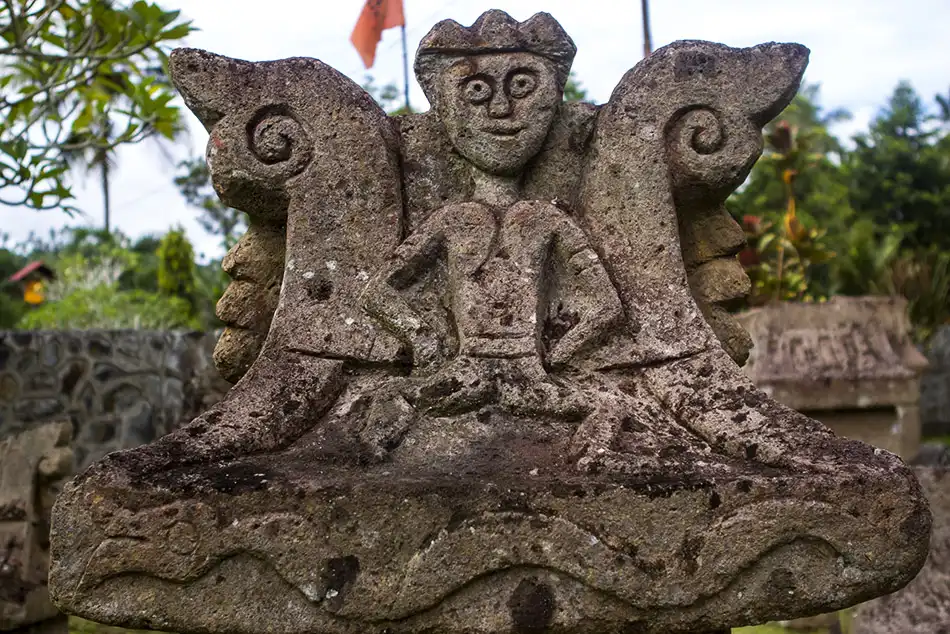
Ancient Waruga rock carvings
Manado Cuisine
Minahasan cuisine is renowned for its bold flavors, unique ingredients, and spicy dishes. Influenced by the diverse cultural heritage of the Minahasa people, Manado cuisine offers a rich tapestry of flavors that will delight adventurous food lovers.
One distinctive feature of Manado cuisine is the use of aromatic herbs and spices, such as lemongrass, turmeric, ginger, and chili peppers. These ingredients lend a distinctively spicy and flavorful character to the dishes.
Manado cuisine offers a fascinating blend of flavors, textures, and culinary techniques. It reflects the abundance of local ingredients and the creativity of the Minahasa people, making it a must-try experience for food enthusiasts visiting Manado.
Note: In the past, some communities in the Minahasa region, including Manado, practiced the consumption of dog meat as part of their traditional cuisine. However, it's important to note that this practice has significantly declined over the years, and the consumption of dog meat is now relatively rare and not widely accepted. In addition, snake meat is also consumed.
Today, the majority of the Minahasa people, like many other Indonesians, primarily consume more common types of meat such as chicken, pork, beef, and fish. The focus of Minahasan cuisine has shifted towards the rich and diverse flavors of traditional dishes made with locally sourced ingredients and unique spices.
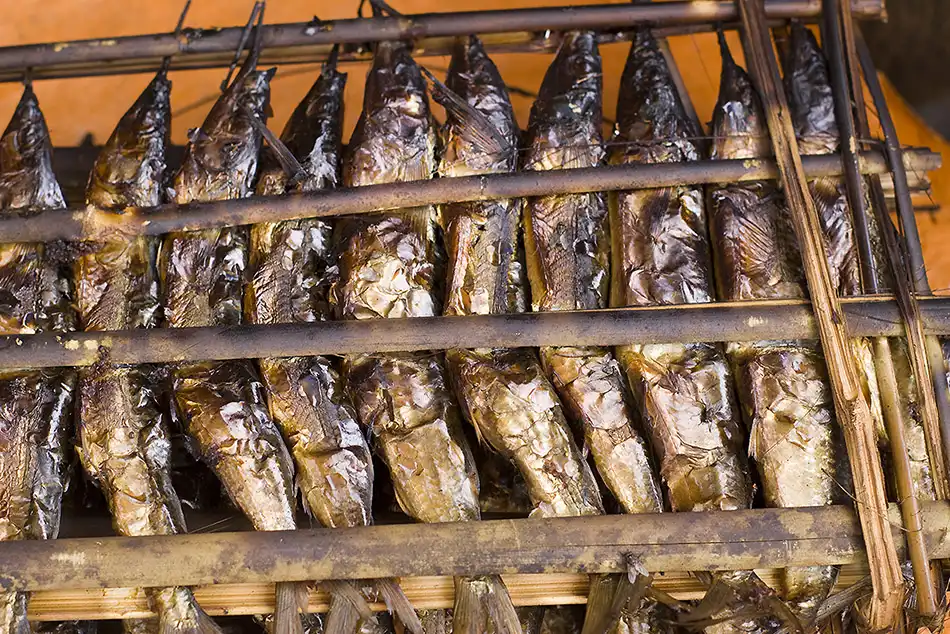
Grilled Fish at Lake Tondano
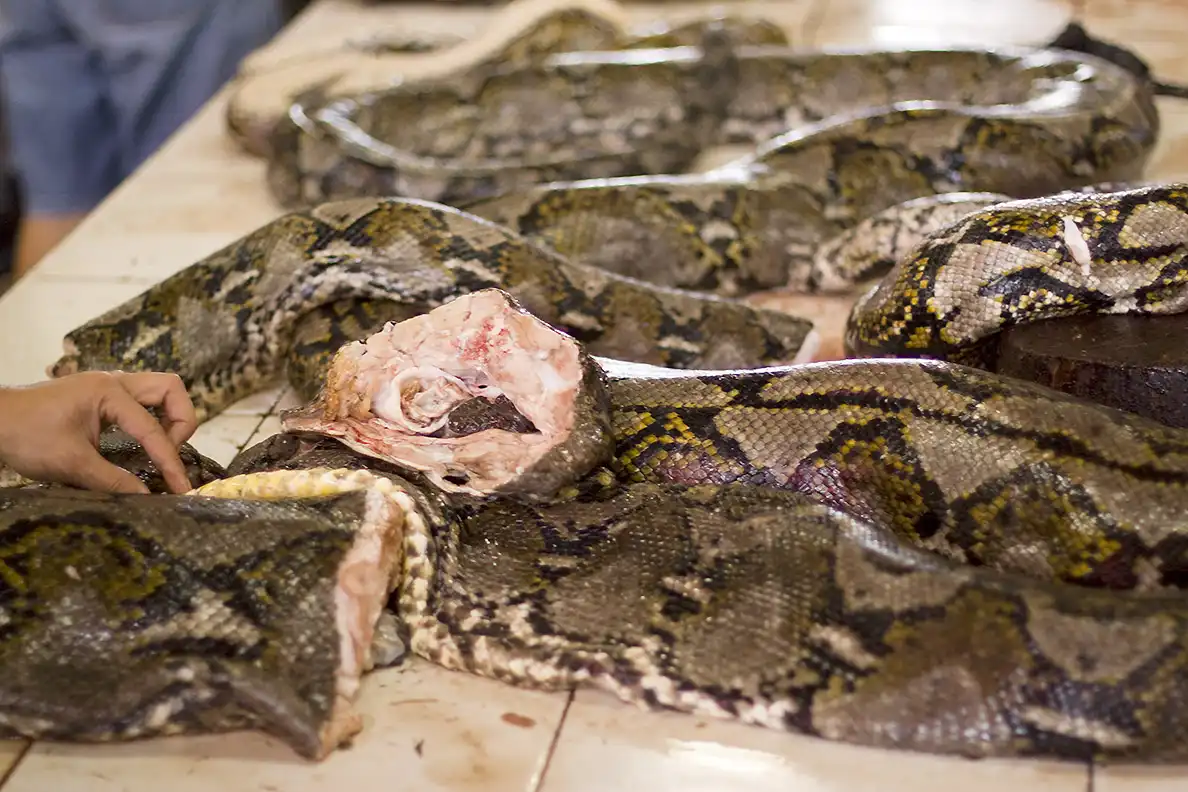
Snake meat for sale at Tomohon Market
What to Eat
Some popular dishes in Manado cuisine include:
- Cakalang Fufu: Smoked skipjack tuna, marinated in a mixture of spices, and then grilled or fried. It is often served with spicy sambal and steamed rice.
- Tinutuan: A traditional porridge made from a mixture of rice, corn, vegetables, and spices. It is commonly served for breakfast and known for its comforting and nutritious qualities.
- Bubur Manado: A rice congee dish cooked with a variety of ingredients such as chicken, beef, or fish, along with spices and garnished with fried onions, celery, and lime juice.
- Dabu-dabu: A spicy condiment made from chopped chili peppers, tomatoes, shallots, and lime juice. It is commonly served as a dipping sauce or condiment for grilled or fried dishes.
- Ikan Rica–Rica: Fish or other seafood cooked in a spicy chili sauce, flavored with lemongrass, lime leaves, and other aromatic herbs. It is a signature dish of Manado cuisine.
- Klapertart: A famous dessert made from coconut, custard, and topped with grated cheese or roasted peanuts. It is a sweet and creamy treat that is widely enjoyed in Manado.
Warning: Not listed in this list though are snake meat and dog meat, both of which are consumed in the region.
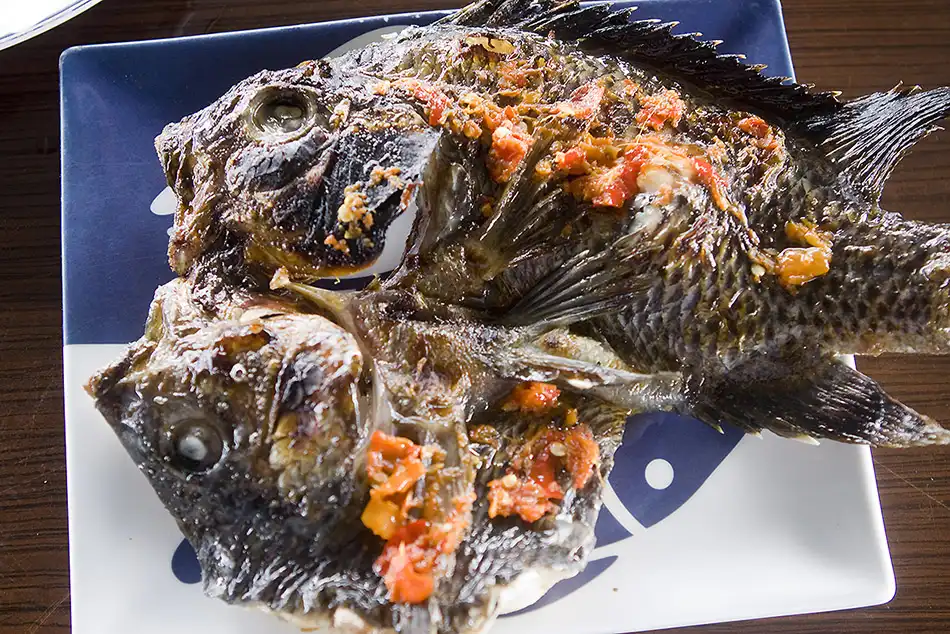
Super spicy grilled fish at Lake Tondano (Ikan Rica–Rica)
Places to Stay
Getting There & Getting Away
Airlines that Fly to Manado
Manado is primarily accessible by air through Sam Ratulangi International Airport, which serves as the main gateway to the city.
It should be noted that the Indonesian aviation scene is very dynamic, with many carriers coming and going. Also note that in the past there have been quality and safety issues with some airlines, so please check the latest situation carefully.
- Lion Air - Flies from Jakarta, Surabaya, Makassar, Denpasar, Balikpapan, and other Indonesian cities
- Garuda Indonesia - Flies from Jakarta, Makassar, Surabaya, Denpasar, and other Indonesian cities
- AirAsia - Flies from Jakarta and Denpasar
- Sriwijaya Air - Flies from Jakarta and Makassar
- Batik Air - Flies from Jakarta
- Citilink - Flies from Jakarta, Surabaya, Makassar, Denpasar, and other Indonesian cities
- Wings Air - Flies from Manokwari, Sorong, and other Indonesian cities
- SilkAir - Flies from Singapore
- Singapore Airlines - Flies from Singapore
- Cathay Dragon - Flies from Hong Kong
Ferries
The nearby port of Bitung in North Sulawesi, Indonesia, serves as an important transportation hub in the region, and is the main port for Manado. Several ferry companies operate routes to and from Bitung, connecting it to various destinations. Here are some of the ferry services that have been available from Bitung:
- PT PELNI (Persero) - PT Pelayaran Nasional Indonesia (Persero) operates passenger and cargo ferries serving multiple destinations from Bitung, including ports in Sulawesi, Maluku, Papua, and other islands in the Indonesian archipelago.
- ASDP Indonesia Ferry - ASDP Indonesia Ferry is a state-owned ferry operator that provides services between Bitung and the nearby islands. They offer both passenger and vehicle transportation, connecting Bitung to islands like Lembeh, Bangka, and Talise.
- Various local operators - In addition to the larger ferry companies, there are smaller local operators that offer ferry services from Bitung to nearby islands. These operators may provide transportation to more remote destinations or cater to specific routes or communities.
Please note that ferry services can be subject to changes in schedules, routes, and operators. It's advisable to check with local travel agencies, ferry terminals, or online resources for the most up-to-date information regarding the ferry operators and their services operating from Manado.
Please also check the seaworthiness of local ferries before boarding. Although very popular, many ferries have been lost at sea
Practical Considerations
Visa, Health and Passport Requirements
For visa information, the Indonesian visa requirements are documented by the indonesian Immigration Department here
U.S. State Department Travel Warning for Indonesia
Australian Government Indonesia overview page
Planning
Ensure a comfortable and enjoyable trip by planning accordingly. Manado has a tropical climate, so pack lightweight and breathable clothing, along with comfortable walking shoes. It's advisable to carry a small backpack with essentials like sunscreen, insect repellent, and a refillable water bottle. English may not be widely spoken, so having a pocket phrasebook or learning a few basic Indonesian phrases can be helpful. Also remember that Indonesia is a conservative country, especially when you get to the more remote areas
It is worth noting that in many areas in Asia, the authorities are not actually helpful in resolving issues, and it is better to plan ahead or trust locals for assistance.
Indonesia is a very diverse country, and Indonesians speak many different languages. Bahasa Indonesia is the standard language used across the country, and an Indonesian Phrasebook is definitely useful
Summary
The Minahasa region in North Sulawesi, Indonesia, is a hidden gem waiting to be discovered. With its breathtaking landscapes, rich cultural heritage, and warm hospitality, Minahasa offers a unique and memorable experience for travelers.
From the vibrant city of Manado to the tranquil beauty of Tondano Lake and the lush hills of the Minahasa Highland, there is something for everyone in this diverse region.
Explore the underwater wonders of Bunaken National Marine Park, renowned for its vibrant coral reefs and diverse marine life. Snorkeling or diving in these pristine waters is an absolute must.
Immerse yourself in the rich cultural heritage of the Minahasa people. Visit traditional villages, witness traditional ceremonies, and marvel at the intricate craftsmanship displayed in the local handicrafts.
Taste the flavors of Minahasan cuisine, known for its bold and spicy dishes. Indulge in local delicacies such as Cakalang Fufu, Tinutuan, and Dabu–dabu, and experience the unique culinary traditions of the region.
Embark on outdoor adventures in the Minahasa Highland, with opportunities for hiking, trekking, and wildlife spotting. Explore the stunning landscapes, terraced rice fields, and picturesque waterfalls that make this region so captivating.
Don't miss the chance to witness the traditional funeral rituals at the Waruga ancient burial sites, a fascinating glimpse into the rich cultural practices of the Minahasa people.
Whether you're seeking natural beauty, cultural immersion, or culinary delights, the Minahasa region offers a truly unforgettable experience that will leave you with lasting memories.
Copyright © 2025 travel-with-mark.com. All rights reserved. No part of this website or any of its contents may be reproduced, copied, modified or adapted, without the prior written consent of the owner, unless otherwise indicated for stand-alone materials. Unauthorized use is strictly prohibited. All trademarks, service marks, and trade names used in this website are the property of their respective owners and are used for identification purposes only. Your access to and use of this website is subject to our terms and conditions. Details of our privacy practices may be found in our privacy notices